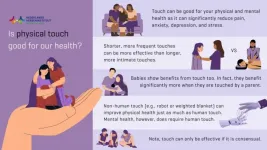(Press-News.org) Through a large-scale analysis, researchers at the Netherlands Institute for Neuroscience have uncovered the ways in which consensual touch can benefit a person’s physical and mental wellbeing.
You might recognize the comforting feeling when someone offers you a hug at the end of a stressful day or strokes your shoulder when you’re feeling down. But the question remains: can touch really help you feel better, and does it matter who it’s from or how they touch you? To explore these questions, researchers from the Social Brain Lab at the Netherlands Institute for Neuroscience and the University Hospital Essen conducted a large-scale analysis of studies exploring touch interventions.
The benefits of touch on mental and physical health
Does touch truly improve someone’s wellbeing? It is an easy question to ask but more complicated to answer. Individual studies often only focus on specific instances and may contradict each other. Combining all these studies together for a large-scale analysis offers a clearer answer: yes, touch substantially improves both physical and mental wellbeing, for example via reduction of pain, anxiety, depression, and stress in adults. But in fact, those with physical or mental health problems (and therefore most in need of support) benefit even more from touch than healthy adults. “This is especially relevant considering how often touch interventions are overlooked” Packheiser, first author, adds.
“A key question of our study is to leverage the hundreds of individual studies out there to identify what type of touch works best,” adds professor Keysers, director of the Social Brain Lab. “What if you don’t have a friend or partner close by to hug you? Would touch from a stranger or even a machine also help? And how often?. The study clearly shows that touch can indeed be optimized, but the most important factors are not necessarily those we suspect.”
Interestingly, the person touching you, how they touch you, and the duration of their touch doesn’t make a difference in terms of impact. A long-lasting massage by a therapist could therefore be just as effective as a quick hug offered by a friend. That is, until the frequency of the intervention is considered. The more often a touch intervention is offered, the greater the impact. A quick hug could therefore be even more impactful than a massage if it is offered more frequently.
Human or non-human touch?
The next question was whether touch intervention needs to be human at all. As it turns out, object or robot interventions can be equally effective at improving physical wellbeing. “There are lots of people in need of wellbeing improvements, perhaps because they’re lonely but also because they may be inflicted by clinical conditions. These results indicate that a touch-robot, or even a simple weighted blanket has the potential to help those people”, last author Frédéric Michon explains. However, the benefits of robot and object interventions are less effective for mental wellbeing. Mental health disorders like anxiety or depression might therefore require human touch after all, “perhaps suggestive of the importance for an emotional component associated with the touch”, Michon point out.
While the researchers were equally curious about human-to-animal contact, studies exploring this question are still lacking. “It would be useful to see whether an animal’s or pet’s touch could improve wellbeing, and inversely if they also benefit from it, but unfortunately there simply aren’t enough studies, or properly controlled ones, for us to draw any general conclusions on these topics”, Michon clarifies.
Touch interventions across ages
When the team looked into the impact of touch on newborns, they found out that newborns also benefited significantly from touch. However, the person conducting the touch intervention was more important: the benefits of touch are higher when done by a parent instead of a healthcare worker. “This finding could be impactful”, Packheiser adds. “Death rates due to premature births are high in some countries and the knowledge that a baby benefits more from the touch of their own parent offers another easily implementable form of support for the baby’s health”.
Due to a lack of studies, it proved difficult to draw conclusions about children and teenagers. “Large scale studies like this help us draw more general conclusions but they also help us identify where research is lacking”, Michon explains. “We hope that our findings can steer future research to explore lesser-known questions. This includes animal touch, but also touch across ages, and in specific clinical settings like autistic patients, another category that has not been explored extensively”.
Source: Nature Human Behaviour
END
New study highlights the benefit of touch on mental and physical health
2024-04-08
ELSE PRESS RELEASES FROM THIS DATE:
Wyss Institute’s AminoX project receives funding from Northpond Labs to accelerate innovation in protein-based therapeutics
2024-04-08
(BOSTON) — The Wyss Institute for Biologically Inspired Engineering at Harvard University and Northpond Ventures announced today that the VC firm’s affiliate Northpond Labs has signed an agreement to support the development of the AminoX project toward commercialization. This is the fourth Wyss project selected by Northpond Labs for additional funding.
Established in 2020 with the involvement of Harvard’s Office of Technology Development, the five-year strategic research alliance created The Laboratory for Bioengineering Research and Innovation at the Wyss Institute through a $12 million commitment from Northpond Labs to support impactful research ...
How scientists are accelerating chemistry discoveries with automation
2024-04-08
A new automated workflow developed by scientists at Lawrence Berkeley National Laboratory (Berkeley Lab) has the potential to allow researchers to analyze the products of their reaction experiments in real time, a key capability needed for future automated chemical processes.
The developed workflow – which applies statistical analysis to process data from nuclear magnetic resonance (NMR) spectroscopy – could help speed the discovery of new pharmaceutical drugs, and accelerate the development of new chemical reactions.
The Berkeley Lab scientists who developed the groundbreaking technique ...
An inside look at how plants and mycorrhizal fungi cooperate
2024-04-08
For millions of years, underground fungi have lived in symbiosis with plant roots. Plants provide photosynthesized carbon, while fungi deliver water and nutrients. In order to do so, these organisms share space at cellular scale: fungi stretch a network of tendrils called arbuscules into a plant’s root cells, and both organisms rearrange their cells around this structure to facilitate sharing.
Recently, researchers have been able to study both sides of this interaction up close, using RNA sequencing to understand gene expression: one of the first cross-kingdom spatially-resolved transcriptomics studies to date. This paper ...
Do opponents’ race, gender, and party impact US congressional fundraising?
2024-04-08
Donations for a political candidate can be motivated by support for that candidate or by opposition to the candidate’s opponent. New research published in Social Science Quarterly found that female Democrats and non-white male Democrats in the United States have a fundraising advantage when running against a white male Republican. Female Republicans or non-white male Republicans do not have this advantage when running against white male Democrats.
To assess the impact that race, gender, and party ...
Preventive ablation of ventricular tachycardia avoids shocks and hospitalisation
2024-04-08
Berlin, Germany – 8 April 2024: The first randomised trial to investigate preventive ablation of a potential arrhythmogenic substrate associated with coronary chronic total occlusion (CTO) in patients at high risk of ventricular arrhythmias (VAs) reduces the risk of appropriate implantable cardioverter-defibrillator (ICD) therapy and unplanned hospitalisation in patients with no previously recorded VAs. The late-breaking science is presented at EHRA 2024, a scientific congress of the European ...
Cleveland Clinic’s Dr. Matt Kalaycio appointed Chair of Board of Directors for National Comprehensive Cancer Network
2024-04-08
PLYMOUTH MEETING, PA [April 8, 2024] — The National Comprehensive Cancer Network® (NCCN®)—a nonprofit devoted to patient care, research, and education—is announcing the election of Matt Kalaycio, MD, FACP, as Chair of the Board of Directors, with Christopher H. Lieu, MD, elected as Vice-Chair, succeeding Dr. Kalaycio in the position he has held since 2022.
“The exemplary leadership from our board of directors is invaluable as NCCN defines and advances high-quality, high-value, patient-centered cancer care around the world,” said NCCN Chief Executive Officer Crystal S. Denlinger, ...
War in Ukraine is increasing the prevalence of mental health conditions in children, new study finds
2024-04-08
A new study presented at the European Psychiatric Association Congress 2024 reveals a significant rise in mental health issues among children and adolescents displaced by the war in Ukraine. The research, conducted by the Institute of Forensic Psychiatry of MoH of Ukraine, highlights the devastating impact of prolonged exposure to violence and displacement on the mental well-being of young people.
As per UNICEF’s recent report on “The State of the World’s Children 2021”, the current COVID-pandemic ...
Using pulp and paper waste to scrub carbon from emissions
2024-04-08
Researchers at McGill University have come up with an innovative approach to improve the energy efficiency of carbon conversion, using waste material from pulp and paper production. The technique they’ve pioneered using the Canadian Light Source at the University of Saskatchewan not only reduces the energy required to convert carbon into useful products, but also reduces overall waste in the environment.
“We are one of the first groups to combine biomass recycling or utilization with CO2 capture,” said Ali ...
First-in-human study demonstrates reduction of hard-to-reach ventricular tachycardias
2024-04-08
Berlin, Germany – 8 April 2024: A new technology using ultralow temperature cryoablation (ULTC) has eliminated clinical ventricular tachycardia (VT) in 94% of patients. The late-breaking science is presented at EHRA 2024, a scientific congress of the European Society of Cardiology (ESC).1
VT is a leading cause of sudden death in patients with heart failure and a reduced ejection fraction.2 Approximately 30% of patients with ischaemic and non-ischaemic cardiomyopathies develop ventricular arrhythmias including VT.3 Typical therapies to prevent VT include antiarrhythmic medication, such as amiodarone, and an implantable ...
McMaster researchers create first-ever guidelines to help kids build tolerance to food allergens
2024-04-08
Researchers with McMaster University have crafted the first-ever guidelines to help prepare families who plan to build their child’s tolerance to common food allergens.
These international guidelines, published on April 8, 2024 in the Journal of Allergy and Clinical Immunology, standardize the preparation process for families considering oral immunotherapy, a process that involves giving very small amounts of an allergen, like peanuts, to patients and gradually increasing the amount to build up their tolerance.
Until now, ...




